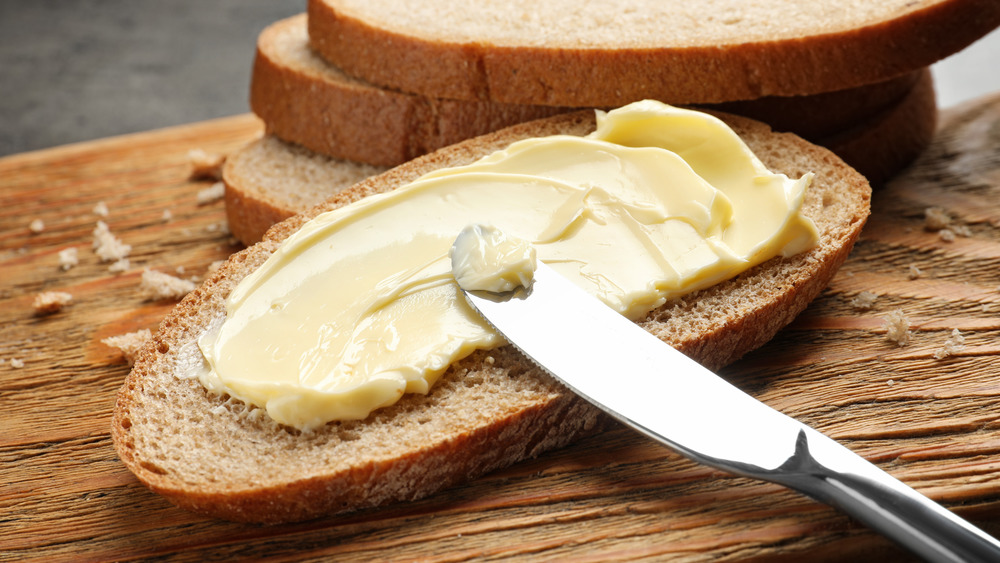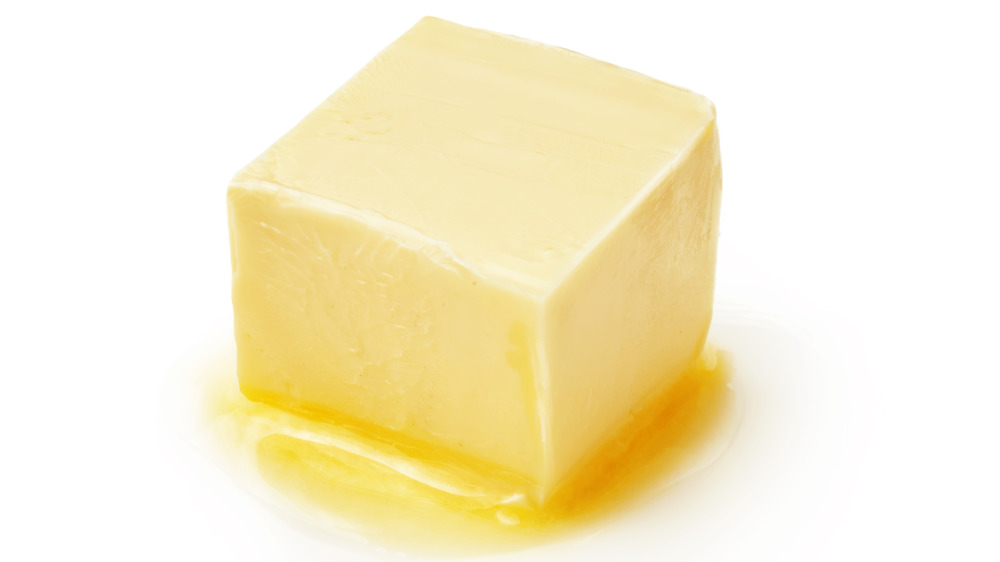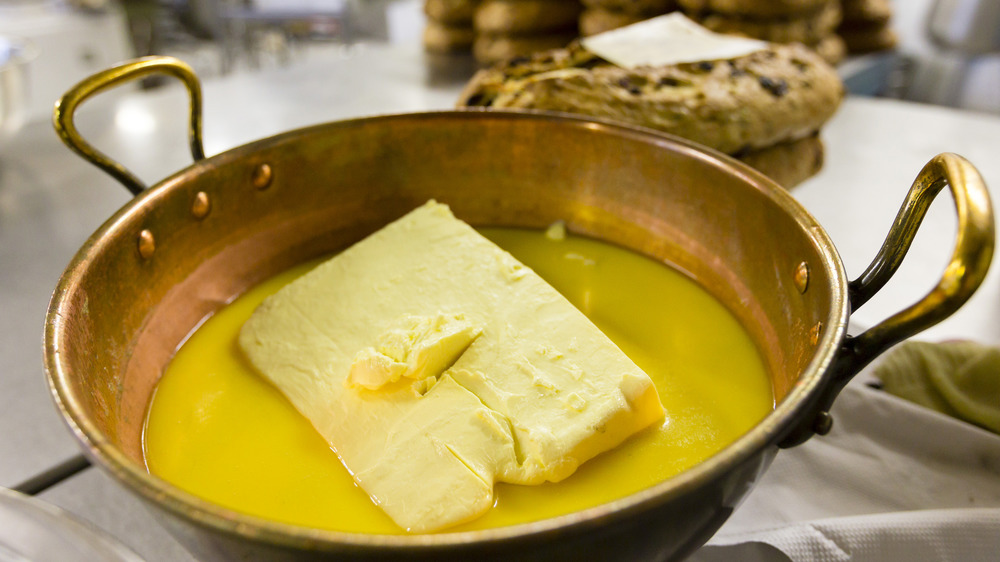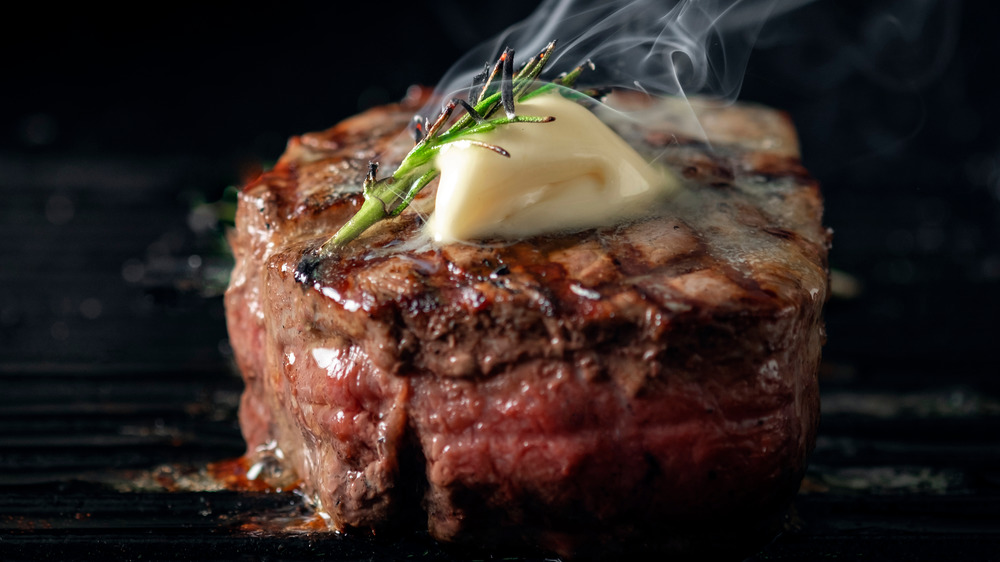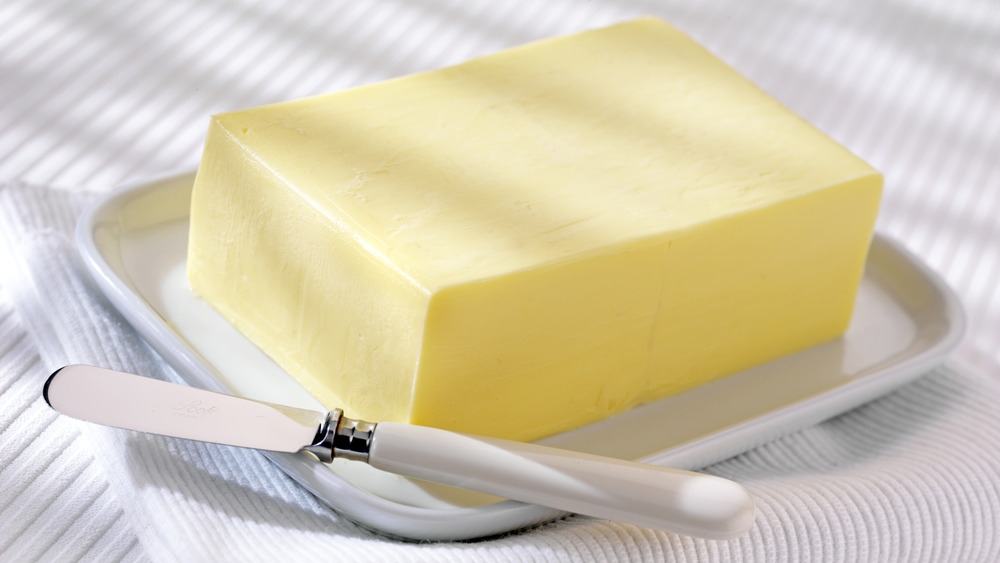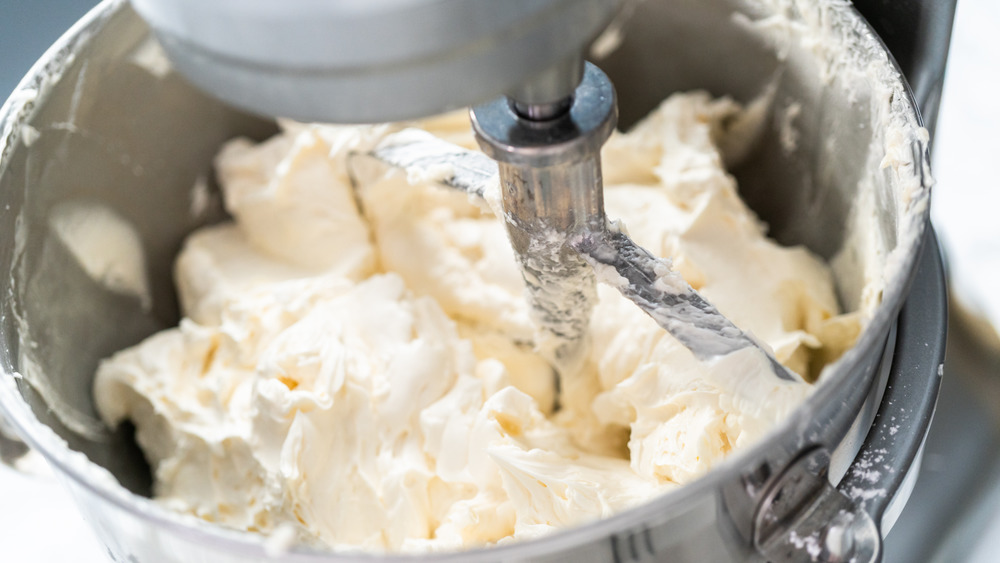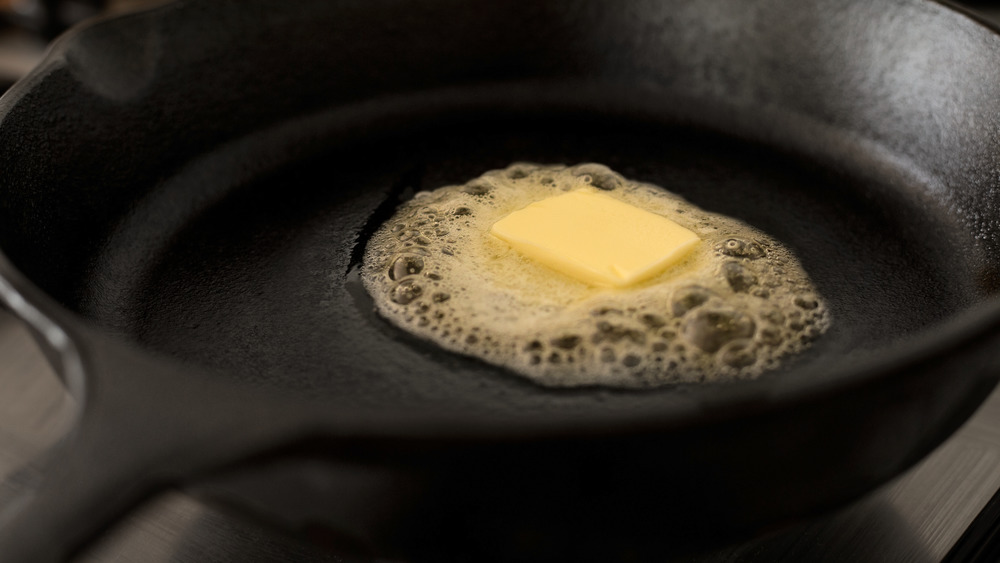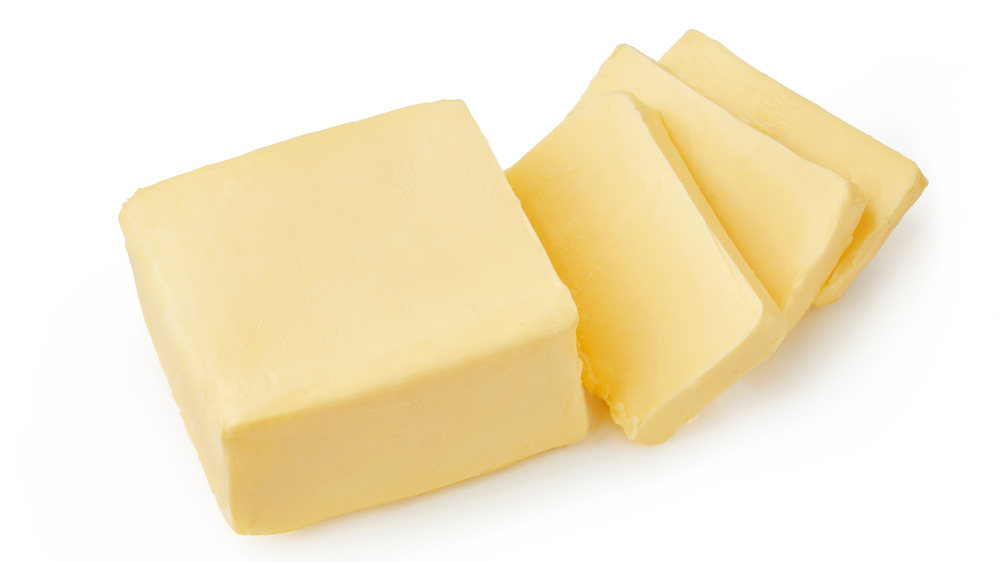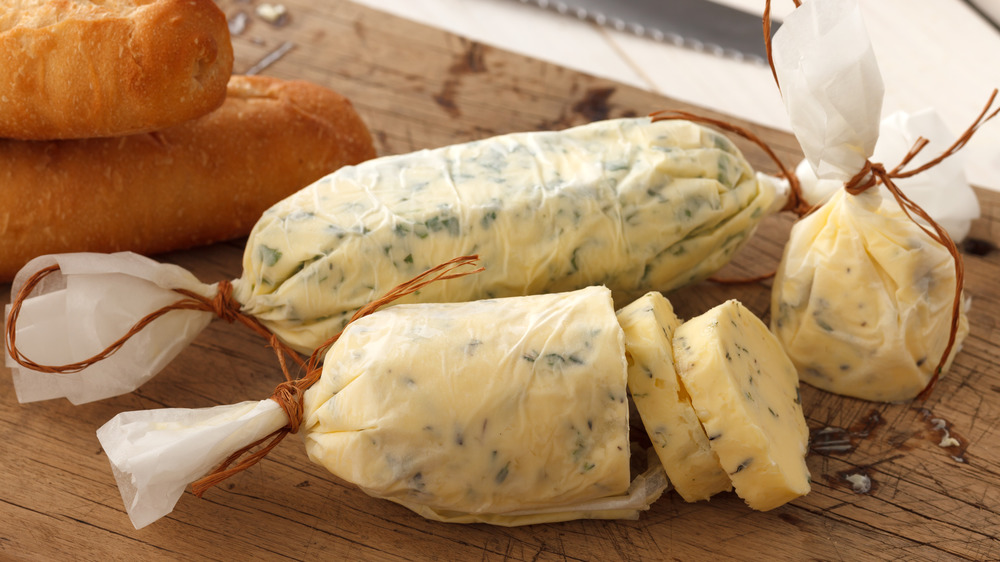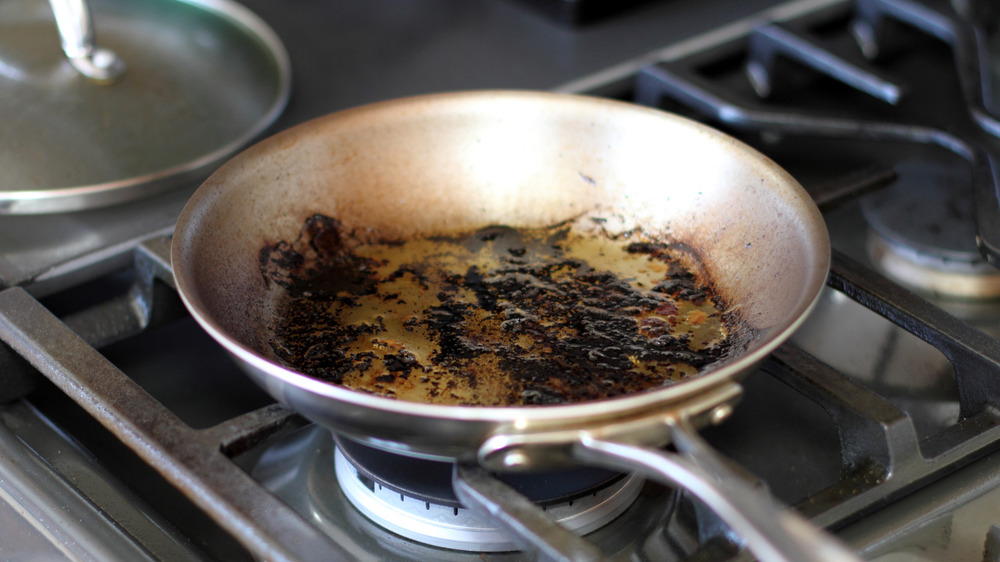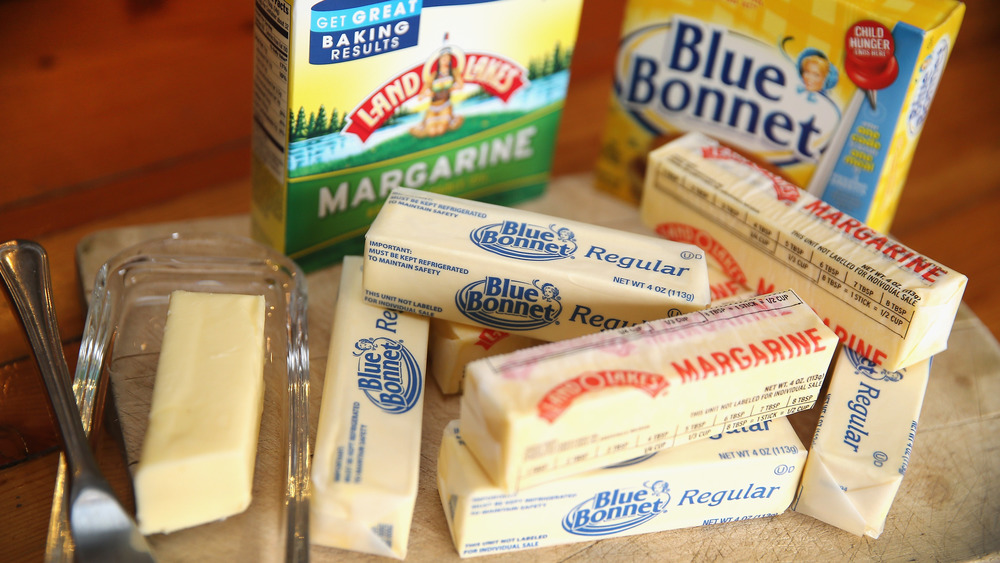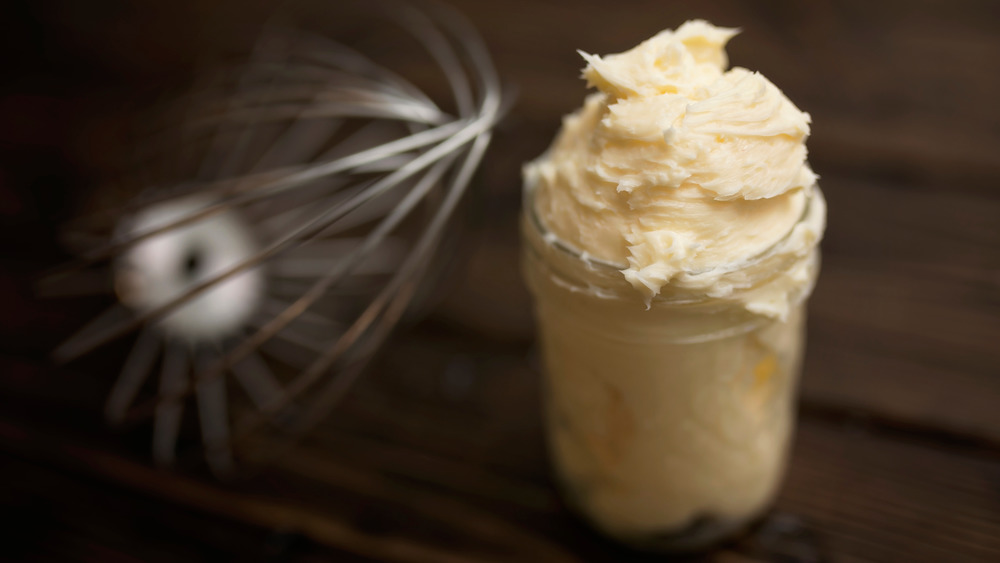Mistakes Everyone Makes Cooking With Butter
Ah, butter. One of the cornerstones of cuisine around the world. It's at times salty, at times sweet, and you can use it for just about everything from baking to frying, and beyond. You can mix other ingredients into it for delicious compound butter that looks like it belongs on the finest of fine dining restaurant tables. Heck, if you're into it, you can use it to make elaborate sculptures worthy of state fair ribbons. Basically, you don't need to be Paula Deen to know that butter is the LeBron James of the cooking world.
Like with any ingredient, though, you can still screw up when using it, and do so pretty easily if you don't know what you're doing. Are you using too much? Too little? Do you know what temperature your butter should be? Does that even matter? And what is all the hubbub about salted butter? While none of the mistakes we're about to discuss are necessarily catastrophic if you're tasked with making Little Timmy's birthday cake, do you really want to be forever known as the one that ruined Timmy's 5th birthday? Take care to avoid these common mistakes made while cooking with butter.
The temperature of the butter is all wrong
The most successful way to consistently produce amazing baked goods is to follow the recipes in front of you. Sure, there is a little room for improvisation, but baking requires more precision than more cooking. So, following the recipe is especially key. This is perhaps no more important than when it comes to butter. According to Bon Appetit, if the recipe calls for a specific temperature butter, like room temperature or melted, then you had best do whatever the recipe says. Not doing so will almost certainly doom your project. The need for the proper temperature butter reflects the physics going on in the baking process. Butter in its different forms functions differently, allowing for other chemical reactions to happen. What can happen in melted butter cannot necessarily happen in room temperature butter, and so on.
Obviously, if you are going to use it for frying this matters less as you will be melting the butter in order to cook with it. For baking, however, paying attention to the butter temperature called for in the recipe is critical.
You over-soften the butter by mistake
If a recipe calls for softened butter, you want it softened, but not melted, which is can definitely happen if you let the butter sit out for too long (via Learn to Cook). If this happens and you continue to use it in the recipe, your baked good is not going to turn out how you want. Instead, it will be much denser. When checking to see if your butter is properly softened, it should give just a little when pressed.
If you do happen to over-soften the butter, don't worry. You can fix it easily enough. To save over-softened butter, you need to rapidly chill the melted butter so that the structures inside the butter reform. While sticking the butter in the fridge may sound like a good idea, it will not chill fast enough. Instead, toss a few ice cubes into the butter and stir. Soon, the butter should be back in a softened stage and can be used once you remove the ice cubes from the bowl.
You add the butter too soon when cooking
Even though you might want to jump in feet first and throw butter into your cooking pan with whatever you are cooking – a nice ribeye, perhaps – don't. Doing so will overcook and burn the butter long before the meat is ready to go, leaving you with bitter black burned butter. Because there are milk fats in butter, cooking them over too-high heat or for too long (or, gasp, both) will ruin the butter in ways that cooking with other oils would not. If you still want to cook with butter and save the flavor, Fox News recommends that you add it towards the end of the process. That will give the butter just long enough to quickly melt without overdoing it. This will also unlock the aromas and flavors of the butter and only add to your dish. One thing to think about when doing this, too, is using a compound butter to bring out other flavors to complement those of the freshly-melted butter.
You mistake salted butter for unsalted
Have you ever looked at a baking recipe, saw that it calls for unsalted butter, but realized you only had salted butter in your fridge, then used the salted butter anyway? Well, sorry to tell you, but that was a wrong move. On a very basic level, unsalted butter helps you keep track of how much salt is going into a dish. When it comes to baking, this is important, as no one wants a chocolate cake to taste as if it came straight out of a salt mine. Turns out, there is definitely a difference between salted and unsalted butter.
If you do not have unsalted butter but need it, all hope is not lost. To correct this, you will have to adjust the other ingredients in the recipe. Each tablespoon of salted butter adds about 90 milligrams of salt to your dish. If you're using salted butter, also be sure to taste your food while cooking so you can adjust flavors on the fly. You don't want to get to the end of the dish and realize that whatever you've made is borderline inedible, or at the very least going to spike the level of sodium in your blood.
You swap out the wrong butter substitute
Oil and butter are not created equally, according to Southern Living. If you're trying to be healthier by using something other than butter when cooking, it's important to understand how other fats like oil work in comparison to butter. Generally speaking, if your recipe does not offer a replacement for butter, tread carefully when you're seeking out substitutes for butter. Well, unless you're a molecular scientist, in which case you probably understand the different compositions of cooking oils in the first place.
Just because two fats may look alike, such as softened butter and semi-solid coconut oil, does not mean they function in the same way while your food is cooking. If you do decide to forgo the above advice, you will change the chemical makeup of whatever you are attempting to make and will, therefore, interrupt the chemical reactions necessary to cook your food correctly. When looking to substitute oils in other cooking formats, such as on sautéing or frying on the stovetop, pay careful attention to the smoke point. No one wants to use an oil with a low smoke point, such as extra virgin olive oil, when a recipe calls for an oil with a high smoke point, like safflower oil. Mixing these up could make for an icky, smoky mess in your kitchen.
You stop creaming your butter too soon
Creaming is the process of mixing softened fat, like butter, with sugar. The most likely place you're going to see this term is in baking, where creaming is integral in many types of cake batters and cookie doughs. Mixing ingredients like butter and sugar together helps to introduce air to the mixture, which then allows the creamed product to increase in volume. The air bubbles trapped inside stay in the batter or dough and, when baked, help leaven the final product (via Serious Eats).
To get properly creamed butter, you should start with room temperature butter. If it's too hot or too cold, it's not going to cream properly or will simply take too long. According to King Arthur Flour, once you start mixing, you want to look for a pale yellow color and visible peaks forming in the mixture. This usually takes about five minutes with a stand mixer. If you don't cream it long enough, you won't get peaks. If, however, you cream too long, the mixture could turn your baked goods gummy and dense.
You use a dark-colored pan when making brown butter
Brown butter is like butter's older, cooler cousin. It's butter with a bigger, bolder, nuttier flavor that some may even prefer to call liquid gold. Others just call it heaven in a pan. You should definitely consider using brown butter in your kitchen more often. To make brown butter, you cook unsalted butter in a pan until the milk solids turn dark and fall to the bottom of your pan. You can then add this brown butter to practically anything and perhaps make your guests think you spent some time training at Le Cordon Bleu.
The key to having brown butter is, perhaps obviously, the color. If you can't see the color, then how will you know once it's turned brown? You won't. When making brown butter, you want to use a light-colored pan such as stainless steel so that you can visually monitor the change in the butter (via The Kitchn). Without being able to watch the butter turn, you're likely to either not cook the butter long enough or cook it too much. Either way, you won't have a delicious brown butter sauce to use, and that would be a real shame.
You break butter into different-sized pieces while cooking
As with most anything related to cooking and baking, when you do it, you want to do it evenly. Think about all those times that you've bitten into something that was molten hot on the outside, but frozen on the inside. It's not fun. In fact, it's pretty disgusting. If you're looking to cook with butter, especially when making sauces such as brown butter, you want to make every effort to cook things evenly. High-quality cookware and a little know-how go a long way, of course, but the simple act of making sure your butter is broken up into even pieces will go just as far, The Kitchn reports.
If you've ever thrown an entire stick of butter into a pan, you've probably noticed that it doesn't all melt at the exact same time. The stick slowly shrinks like an iceberg in a warm sea. By the time it's all melted, some of the butter has cooked much longer in its liquid form, which could alter the flavor of the final product. In order to have a consistent flavor profile across the sauce or dish, simply make sure you cut the butter into equal-sized pieces before throwing it into the pan. Flavor crisis averted.
You forget to add other flavors to the butter
While butter on its own imparts an amazing amount of flavor to both sweet and savory recipes, butter should not be the only flavoring agent used when you're cooking. You want to use the butter as a flavor aggregator – mixing other things in with it so that those other flavors are bolstered by the richness of the butter. On one hand, this could mean doing something as simple as creating a compound butter. Compound butters are easy to make and can elevate practically anything you might normally eat with butter. Take a steak, for example. When prepared, it might be seasoned with salt and pepper. Take a compound butter with some chives and garlic and let it sit on top of the steak and wham, you've got a fancy restaurant-style plating right in front of you.
On the other hand, working other flavors into dishes with butter is also about balancing the flavor of the butter with any additions. Have you ever tried to eat a pad of butter on its own? It's very rich, to say the least. When cooking with butter, you want something that will work to complement that savory, fatty profile. Citrus, such as lemon juice or vinegar, works particularly well to cut through the richness of the butter (via La Cucina Italiana).
You burn the butter while cooking with it
When cooking with butter, it is crucial to keep an eye on how much you are using and at what temperature. If either of these factors is off while you are cooking pancakes, for example, you're likely going to burn your butter. Not only does burned butter smoke and release a terrible smell, but the milk solids that have burned will turn black and taste bitter. If this happens consistently for you, then first look at the temperature at which you're cooking. High is not always best. You may need to lower the temp – and adjust as you cook – so that the butter does not burn.
According to My Recipes, another easy fix is to simply use less butter. Gasp and cry foul if you must, but just like high heat isn't always the best option, more is not always better when cooking with butter. Start by using just enough to coat the pan. As you work in batches, you will have to periodically add more butter. More work, yes, but this allows you more control and translates to, hopefully, less burnt butter.
You mistakenly use margarine instead of butter
While on the surface, butter and margarine may seem like they are basically the same thing, they are not. According to Mental Floss, margarine was created in 19th century France by the amazingly-named Hippolyte Mège-Mouriès, when Emperor Napoleon III called for a cheap butter substitute that would be given to the lower classes and armed forces. Margarine is made from water and refined fats, where the water droplets are spread throughout the fat emulsion. One of the main reasons people made the switch from butter to margarine is because margarine has a lower amount of saturated fat compared to butter. Yes, this is great to know if you're planning to put some on your English muffin in the morning.
However, if you want higher-quality baked goods, you're going to want to stick with butter. You cannot expect to get the same results cooking with margarine as you would with butter. From a flavor standpoint, butter is going to provide a fuller, richer flavor (which is enough of a reason to use it for many). Margarine will also provide a different texture to baked goods, the Edmonton Journal reports. Because of its lower fat content, margarine is more likely to cause things like cakes and cookies to spread in the oven, which will then cause baked goods to get too thin or even burn.
You mistake store bought butter for the homemade stuff
It's not like butter is a hard ingredient to find, but do you know what is just as easy and entirely more satisfying? Making your own butter. With quarantine still going strong, chances are you've already learned to make your own bread, so why not make your own butter to go on that sourdough? If the thought of making your own butter scares you, stop and take a breath. To make butter, according to AllRecipes, you only need one ingredient: heavy whipping cream. Also, you only need one piece of equipment.
Making your own is incredibly easy, especially if you have a stand mixer or hand blender. If you don't have access to either of those, all you really need is a jar with a tight-fitting lid and a good amount of elbow grease. You'll take your heavy cream, put it in the jar, and shake, shake, shake. At first, it'll turn into whipped cream. Keep shaking. No, you've haven't made a mistake. Soon, after about fifteen minutes, the butter will begin to form. Keep shaking. Eventually, the butter and the buttercream will separate and voila, you have your own butter. Strain the liquids out of the butter solids and enjoy.
